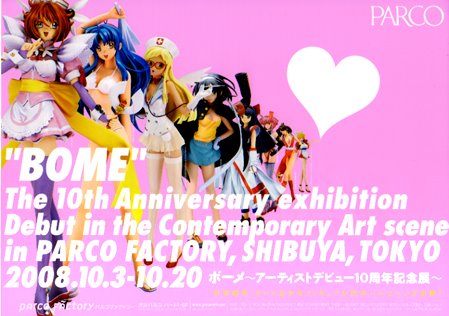I caught a couple of exhibitions last week, one by chance and the other less random; but both were linked by the fact art in Japan these days often has its roots deeply buried in corporate-pop-culture. We probably we have Takashi Murakami to thank for this. Him and his grand Superflat theory—that Japanese don't traditionally make distinctions between "high" and "low" art—have sure made it easier for artists and corporations to come together and produce art for the masses. Populist, fun art that seems easy to understand. But art that doesn't challenge the viewer too much. Branded, corporate art that sells for a fortune; but with copies mass produced to sell in toy stores. Art that's given away with a mobile phone. It's art for everyone, but no one in particular.
I stumbled across the first exhibition in Shibuya when I noticed a bright pink poster advertising a show by BOME—who can most simply be described as a sculptor; a very otaku sculptor. In Japan Bome is best known for his sexy three dimensional figurines of anime-style girls, including the Monseiur BOME series of collectible figurines from Kaiyaido. These are sexy dolls for pervy boys; of big-busted babes with ridiculously long legs. They're the 6 inch girlfriends of otaku (to quote Patrick Maccias). And they seem almost, how can I put this? Possible.
Bome's skill is taking the absurd proportions of women in the two-dimensional world of anime and manga, and transforming them into glorious, eye-popping 3D. This is why he has so many fans; because he has overcome what otaku call the "three-dimensional contradiction" that the girls who exist on the pages of manga could not possibly exist in the real world. The weight of their breasts alone would mean the poor girls' backs would give out! But somehow, Bome's figures pull it off and the illusion of possibility is what makes these dolls such a tease. This skill is also what caught Takashi Mukrakami's eye many years ago.
With the help of Murakami, Bome's work has managed to emerge from the dark geeky ghetto of figure-collecting otaku into the glare of the international art world. And ever since 2003 when his 1997 collaboration with Murakami—a sculpture called "Miss ko2 (Project ko2)"— fetched US$567,500, the highest price ever paid for a piece of contemporary Japanese art at the time, Bome has been known overseas as an artist to keep an eye on. The show at Parco Factory is billed as the 10th anniversary of the artist's debut into the contemporary art scene, but it's essentially a show for otaku. Many of Bomes original figures are on display, and from his most early work in the 1980's to the most recent work it's fascinating to see the development of his technique. There are videos showing interviews with him and there's a detailed, step-by-step display of how he makes his dolls. But the best part of the whole exhibition—and the thing that brings all the high-falutin talk of his art world connections back down to earth— is that you can buy the mass produced versions of his figures in the gift shop, for about 4000 yen each.
The second show I went to see was a much more blatant corporate art show, but one that ironically had art of a more traditional taste, and very different flavour. "How to cook a Docomodake" is a collection of work by sixteen artists who were invited my the mobile phone company NTT Docomo to produce art that was inspired by the company mascot, a mushroom called the Docomodake. The exhibition first showed in October 2007 in New York, and was a very clever way for Docomo—who are not at all well known in the US—to introduce both their brand and their popular mascot. In Tokyo the character needed no introduction and the show was still packed when I went to see it on the closing day. 
Essentially all the artists involved had deconstructed the well known character and presented it in their own way. Rika Eguchi, presented the Docomodake served up as if cooked in different ways, grilled, sliced, diced and rather over-cooked. This work was the most "cute" of all the work there, but not the best. My personal favourites were the detailed, psychedelic, pencil drawing by KYOTARO entitled "The Sleeping Forest" and of course "Yokai - Japanese Ghost - Dokomodake" by MUSTONE (pictured above). I also really liked the jacket and skirt by ANREALAGE, who has taken apart hundreds of stuffed Docomodake toys, including the small "screen-cleaner" versions that hang off people's mobile phones, and sewn them together to make his patchwork fashion (below).
Both these exhibitions could be criticised by a more serious art critic for being shallow, and vapid extensions of a post-modern society that doesn't quite know how to stop feeding upon its own pop offspring and start producing meaningful art again. But I liked it.
"BOME" The 10th Anniversary exhibition Debut in the Contemporary Art scene in PARCO FACTORY, SHIBUYA, TOKYO runs until October 20th, 2008
How to cook a Docomodake was at the Intercommunication Center at Tokyo Opera City but ended on October 13th, 2008
17/10/2008
Bome vs Docomodake
Subscribe to:
Post Comments (Atom)





No comments:
Post a Comment